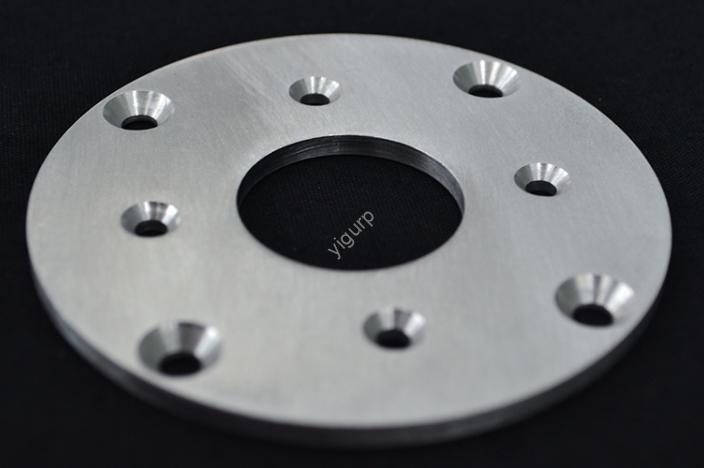Wenn es um CNC -Metallprototyp geht (Auch als CNC -Metallprototyp bekannt) Bearbeitung, Das Erreichen einer hohen Oberflächenqualität und -präzision ist entscheidend. Ein wichtiger Nachbearbeitungsschritt, der die Leistung und Erscheinung des Endprodukts direkt beeinflusst, ist Enttäuschung. Burrs - die kleine, Unerwünschte Metallprojektionen, die beim Schneiden gebildet wurden, Bohren, oder Fräsen - können Versammlungsprobleme verursachen, Schadensinstrumente, und sogar Sicherheitsrisiken darstellen. In diesem Leitfaden, Wir werden die effektivsten Abgrenzungsmethoden für CNC -Metallprototypen aufschlüsseln, Helfen Sie Ihnen, das richtige für Ihr Projekt auszuwählen, und teilen Sie Tipps, um die Burrs von Anfang an zu minimieren.
1. Häufige Entbündungsmethoden für CNC -Metallprototypen
Nicht alle entbrennenden Methoden funktionieren für jeden Prototyp. Die Wahl hängt von Faktoren wie Teilkomplexität ab, Material, Chargengröße, und Präzisionsanforderungen. Unten finden Sie eine detaillierte Aufschlüsselung der am häufigsten verwendeten Techniken, zusammen mit ihren Profis, Nachteile, und ideale Anwendungsfälle.
| Abgussmethode | Kernprinzip | Idealer Anwendungsfall | Effizienz (1-10) | Präzision (1-10) | Kostenniveau |
| Manuelles Entwerfen | Verwenden von Handwerkzeugen (Dateien, Sandpapier, Schaber) Burrs wegschleifen | Komplexe Prototypen, Kleine Chargen (1-10 Teile) | 3 | 7 | Niedrig |
| Punch Press entlarven | Verwenden einer benutzerdefinierten Form mit einer Punchpresse, um die Burrs abzuscheren | Einfache Prototypen der Flachoberfläche, mittlere Chargen (10-50 Teile) | 7 | 6 | Medium (Schimmelkosten enthalten) |
| Schleifen des Debrimms (Vibration, Sandstrahlen, Stolpern) | Mit abrasiven Materialien (Z.B., Keramikperlen, Sand) an Teilen reiben und Grat entfernen | Große Chargen (50+ Teile), Teile mit mehreren kleinen Gratern | 8 | 5 | Medium |
| Mechanisches Entwerfen | Mit automatisierten Werkzeugen (Bürsten, Schleifräder, Roboter entlarven) Burrs entfernen | Produktion mit hoher Volumen (100+ Teile), Standardförmige Prototypen | 9 | 8 | Mittelhoch |
| Chemische Entlassung | Teile in eine chemische Lösung zur Auflösung von Grat durch chemische Reaktion eintauchen | Prototypen aus bestimmten Metallen (Z.B., Aluminium, Kupfer), Teile mit schwer zu erreichen | 6 | 7 | Medium (chemische Kosten) |
| Elektrochemische Abgrunde | Verwenden eines elektrischen Stroms zum Elektrolyzen und auflösen Burrs (Arbeitet mit leitenden Metallen) | Präzisionsprototypen (Z.B., medizinisch, Luft- und Raumfahrtteile) | 5 | 10 | Hoch |
| Wärmebehandlung entblößt | Erhitzen des Prototyps zum Erweichen oder Abbrechen von Burrs (Z.B., Temperaturtemperatur) | Prototypen mit hitzebeständigen Materialien (Z.B., Stahllegierungen) | 4 | 4 | Niedrigmedium |
| Laser debriert | Verwenden eines hochpräzisen Laserstrahls, um Burrs zu verdampfen, ohne das Teil zu berühren | Prototypen von Ultra-High-Precision (Toleranz < 0.001mm) | 6 | 10 | Hoch |
| Ultraschallablößerung | Verwenden von Hochfrequenz-Schallwellen (20-40KHz) um eine flüssige und abrasive Mischung zu bewegen, was Burrs entfernt | Klein, empfindliche Prototypen (Z.B., Mikrokomponenten) | 7 | 9 | Medium |
2. Schlüsselfaktoren zur Auswahl der richtigen Abgrenzungsmethode
Die Auswahl der besten Abgrenzungstechnik ist nicht zufällig. Sie müssen berücksichtigen 4 kritische Faktoren, um Qualität auszugleichen, kosten, und Effizienz:
- Prototypmaterial: Unterschiedliche Metalle reagieren unterschiedlich auf das Entbrennen. Zum Beispiel, Aluminium ist weich und funktioniert gut mit chemischer oder ultraschalltonischer Entlassung, während Edelstahl (härteres Material) Möglicherweise erfordern Laser oder mechanisches Entlüften.
- Teilkomplexität: Komplizierte Prototypen mit inneren Löchern oder schmalen Slots (Z.B., Luft- und Raumfahrtkomponenten) sind mit manuellen Werkzeugen schwer zu erreichen - opt für Ultraschall- oder elektrochemische Abgrunde stattdessen.
- Produktionsstapel: Wenn Sie machen 1-5 Prototypen, manuelles Entwerfen ist kostengünstig. Für 50+ Teile, Schleifen des Debrimms (Vibration/Tumbling) oder automatisierte mechanische Abgraben wird Zeit sparen.
- Präzisionsanforderungen: Medizinische Prototypen oder High-End-Elektronik benötigen häufig Toleranzen unter 0,005 mm-Laser oder elektrochemische Abgrunde ist der einzige Weg, um das Teil zu vermeiden, während Burrs entfernt werden.
3. So minimieren Sie Burrs während der CNC -Bearbeitung (Reduzieren Sie die Nachbearbeitung)
Der beste Weg, um mit Burrs umzugehen, besteht darin, zu verhindern, dass sie sich überhaupt erst bilden. Durch Optimierung Ihres CNC -Bearbeitungsprozesses, Sie können die Auslöste Zeit verkürzen 30-50%. Hier sind 3 Praktische Tipps:
- Wählen Sie Burr-Minimierende Schneidwerkzeuge: Verwenden Sie scharf, Hochwertige Werkzeuge (Z.B., Carbid -Endmühlen für Stahl) und vermeiden Sie abgenutzte Klingen-Dull-Werkzeuge neigen dazu, Metall zu drücken, anstatt es zu schneiden, größere Burrs schaffen.
- Optimieren Sie die Bearbeitungsparameter: Passen Sie die an Schnittgeschwindigkeit, Futterrate, Und Tiefe des Schnitts. Zum Beispiel, Erhöhen Sie die Futterrate geringfügig (innerhalb sicherer Grenzen) kann die Burr -Bildung auf Aluminiumprototypen verringern.
- Design für das Entwerfen: Bei der Ausarbeitung des 3D -Modells des Prototyps, Vermeiden Sie scharfe innere Ecken (Verwenden Sie einen minimalen Radius von 0,1 mm) und hinterlassen Sie zusätzlichen Platz in schwer zugänglichen Bereichen. Dies erleichtert die Nachbearbeitung, Auch für das manuelle Abbau.
4. Die Perspektive der Yigu -Technologie auf den Debrunen des CNC -Metallprototyps
Bei Yigu Technology, Wir glauben. Unser Team kombiniert sich Methodenauswahl mit Prozessoptimierung: für Small-Batch, Komplexe Prototypen, Wir verwenden manuelles Entgraben mit Präzisionsdateien, um sicherzustellen, dass keine Details übersehen werden; für hochvolumige, Standardteile, Wir verlassen uns auf automatisierte mechanische Abgriffen, um die Effizienz zu steigern. Wir priorisieren auch die Vorbereitung der Planung-indem wir Schnittparameter und Werkzeugauswahl anpassen, Wir haben Kunden dabei geholfen, die Abgrenzungskosten um bis zu reduzieren zu können 40%. Das Ziel ist es immer, Geschwindigkeit auszugleichen, kosten, und Präzision, um die einzigartigen Bedürfnisse jedes Kunden zu erfüllen.
FAQ über CNC -Metallprototyp entlarzenen sich
Q1: Kann ich das Entlassung für meinen CNC -Metallprototyp überspringen??
NEIN. Auch kleine Grat können Probleme verursachen: Sie können Paarungsteile während der Baugruppe kratzen, Messungen beeinträchtigen (Präzision beeinflussen), oder Sicherheitsrisiken darstellen (Z.B., Scharfe Kanten können die Hände schneiden). Die Debring stellt sicher.
Q2: Welche Dunkelmethode ist die billigste für Klein-Batch-Prototypen?
Manuelles Entwerfen ist die kostengünstigste für kleine Chargen (1-10 Teile). Es erfordert keine teure Ausrüstung - nur grundlegende Handwerkzeuge wie Dateien und Sandpapier. Jedoch, Es ist arbeitsintensiv, Es ist also nicht ideal für große Chargen.
Q3: Ist Laser, der für alle Metallmaterialien geeignet ist?
NEIN. Laser -Debring funktioniert am besten mit Metallen, die Laserenergie gut absorbieren, wie Stahl, Titan, und Aluminium. Es ist weniger effektiv für hochreflektierende Metalle (Z.B., Kupfer oder Gold), Da kann der Laser von der Oberfläche abprallen, anstatt Grat zu verdampfen. Für reflektierende Metalle, Elektrochemisches Abgraben ist eine bessere Wahl.
